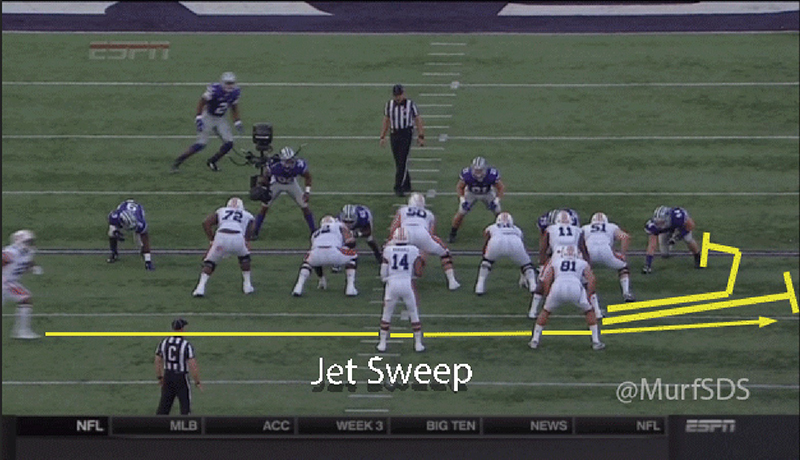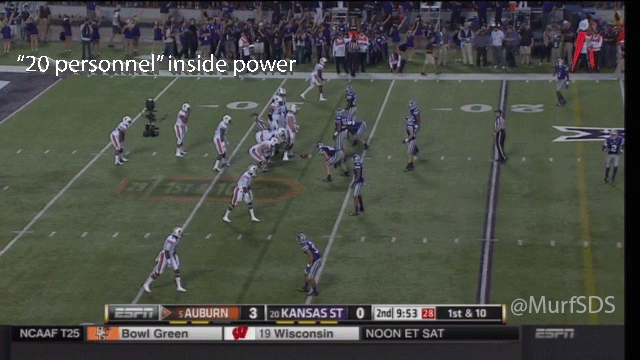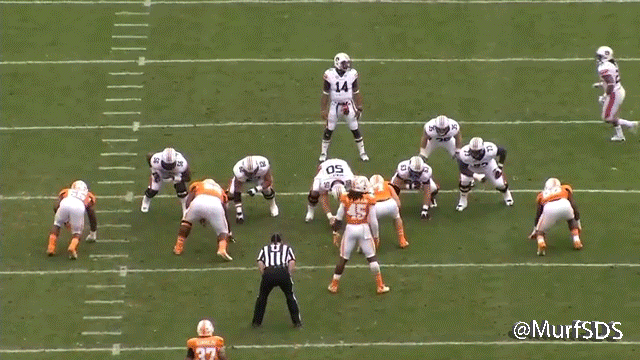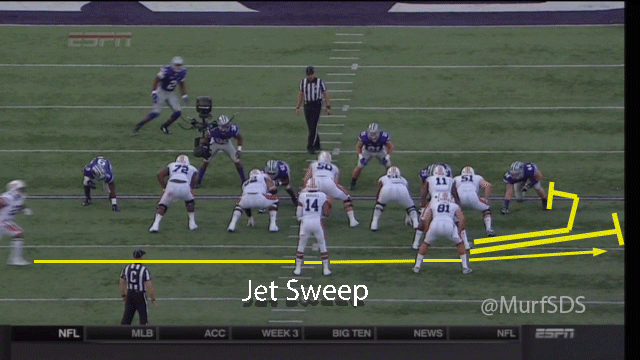Film study: How K-State contained Auburn's vaunted run game
After gaining a hard-fought victory over the surprisingly resilient Kansas State Wildcats, 20-14, the Auburn Tigers must now live with media speculation that the Wildcats provided a blueprint for success on how to stop its ingenious rushing attack.
After appearing as though they could darn-near win a national championship off the strength of the ground game alone, Auburn needed a hearty effort from its defense — along with timely plays in the pass game — to procure victory in the tough environment of Manhattan, Kansas.
While realists, such as myself, think that Auburn finding other avenues to overcome adversity spells doom for the rest of the opponents on its schedule, pessimists will look at it as a sign of vulnerability.
After all, when you led the nation in rushing with a gaudy average of 328.3 yards per tilt, as the Tigers did last season, putting up 128 yards on 45 carries (2.8 average per attempt) won’t suffice in the eyes on most — especially those with designs on forcing Auburn into the similar output.
But while Auburn’s below-average statistical output may be an anomaly, the Wildcats did put some good stuff on film for others to attempt to emulate. Stopping the Tigers is next to impossible, containing them seems more feasible.
Philosophy
Head coach, and evil offensive genius, Guz Malzahn (says most who root for a team other than Auburn) has installed a Nascar-fast, smash-mouth, multiplicative offensive scheme based around spread principles — Counters, Traps, Draws, Power and Iso runs are among the staple of Auburn’s diverse rushing game.
With the threat of the zone-read, from possibly the best running quarterback in the nation in Nick Marshall, combined with the stylings of the inside/out duo of Cameron Artis-Payne and Corey Grant, containing the Tigers’ run game is a crapshoot at best.
Unless you execute a couple of key principles: provide back-side pursuit and funnel all action back to inside traffic.
If you can be effective in these couple of areas you will have a great chance at slowing down Auburn’s high-powered ground game.
But of course, that’s easier written than done.
Back-side Pursuit
When dealing mostly with Auburn’s inside-power game, you want to somehow have edge-rushers provide action from the back side. Your hopes would be that the your front is at the very least able to hold steady at the point of attack, and you can send an unaccounted for defender to pursue back side.
Notice how the initial edge-defender crashed the interior gap in an attempt to further muddy the waters. This provides the second-level defenders more of an opportunity to operate clean as they sift through the trash.
Additionally, the nickel corner bluffs and shows late at the mesh point — the time of the handoff where the QB can let it go or keep it and escape to the edge on a run — further causing confusion for the QB.
The back-side pursuit limits a normally successful play to a short gain.
Conversely, Auburn has shown more of a tendency to hit receivers with passes to vacated areas. So a late show is in the best interest of the defense as Auburn won’t have enough time to adjust.
Funnel Action Back To The Inside
Auburn attacks the perimeter better than any team in the nation. It’s version of the “Jet Sweep” seems indefensible as the back is chaperoned by both a pulling lineman and an H-back on various versions — further adding power to a finesse style play.
Malzahn does such a good job of making a lot of the run concepts look similar initially, and Marshall’s ball-handling wizardry retards the thinking of defenders. You just never know if he’s going to hand the ball off or keep it.
But if Auburn is going to beat you, it should never be to the perimeter. But, once again, that’s easier said than done.
On this particular sequence, the edge-defender was much too concerned with the back threatening the inside opposed to setting the edge. Once the initial edge is breached, the corner becomes the de facto edge-defender.
But he’s not paying attention to what’s going on in the backfield and is stalk-blocked the receiver. If he could’ve funneled the QB back to the inside, the linebacker may have made the play around the line of scrimmage.
As you can see, one hand washes the other; both wash the face
Here’s how K-State played it; the safety came up, filled and strung out the blocker while the back-side pursuit did its work. Sometimes good defense is about being patient and doing your job (hello, coach Bill Belichick!).
If the safety would’ve tried to go under the block, Marshall would’ve undoubtedly caught the edge and gotten something positive out of it.
On this “Jet Sweep,” against K-State, the defensive back did a fantastic job of holding strong on the edge which forces the back to decelerate.
With the the back-side pursuit “scraping” toward the action, the back has to try to bend it back outside — to no avail.
Defending Auburn’s run game takes patience and discipline. But most of all it takes sure tackling. The Tigers force defenders to tackle in space and they a good job of eliminating angles. Trying to get highlight-worthy hits on Tiger players should not be in the cards.
Practical tackling should most certainly on the agenda.
The Wildcats did a wonderful job with the show/fill technique — by making sure a defender showed in the gap, not necessarily shooting it every time, just making sure there was a presence in each interior gap.
But with all that said teams still have to not only execute all those aforementioned techniques, but it must do so with the threat of Auburn throwing “pop” passes from many of these same formations.
Above all else, it’s becoming apparent that Auburn is improving in the passing department which adds a whole new set of headaches for defensive coordinators.
Let’s give credit to Wildcats’ defensive coordinator Tom Hayes as for one game, his unit seemingly did the unthinkable; it contained Auburn’s rushing game…and still lost.
Now that’s scary, folks.




